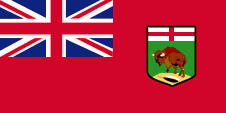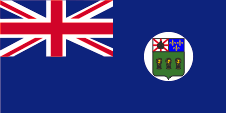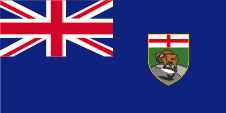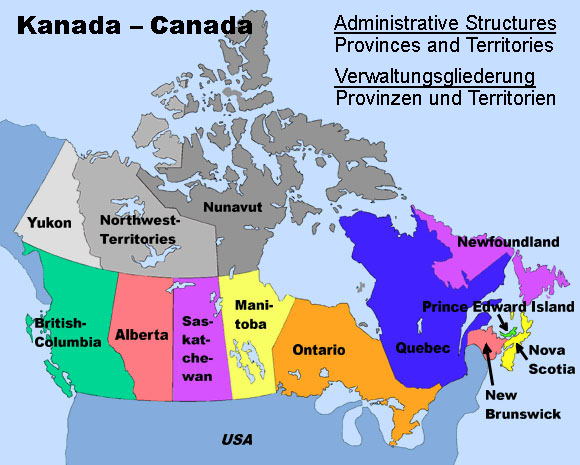Manitoba |
|
|
|
| Übersicht – Contents: | |
Flagge – Flag: |
|
 |
Provinzflagge – flag of the province, Seitenverhältnis – ratio = 1:2, Quelle/Source: Corel Draw 4   |
historische Flaggen – historical Flags: |
|
 |
1870–1905, Flagge der Regierung (Staatsflagge) – flag of the government (state flag), Seitenverhältnis – ratio = 1:2, Quelle/Source, nach/by: World Statesmen, Flags of the World |
 |
1905–1966, Flagge der Regierung (Staatsflagge) – flag of the government (state flag), Seitenverhältnis – ratio = 1:2, Quelle/Source, nach/by: World Statesmen |
Bedeutung/Ursprung der Flagge – Meaning/Origin of the Flag: |
|
| Die Flagge von Manitoba wurde am 12.05.1966 angenommen. Sie orientiert sich am britschen Ensign-System. Dieses und die Verwendung des Union Jack weißt auf die Verbindung zu Großbritannien hin. | The flag
of Manitoba was adoped on 12th of May in 1966. It ist orientated in the
British Ensign System. This cause and the use of the Union Jack point to the connexions to United Kingdom. |
Großbritannien hatte in Jahr 1864 ein Flaggensystem eingeführt, in dem:
Seit 1865 durften Schiffe von Kolonialregierungen einen Blue Ensign mit einem Badge (Abzeichen) im fliegenden Ende führen. Die jeweiligen Regierungen sollten entsprechene Bagdes zur Verfügung stellen. Handelsschiffe und seefahrende Privatpersonen aus Kolonien dürfen nur dann einen Red Ensign mit Badge führen, wenn von der britischen Admiralität eine entsprechende Erlaubnis für die Kolonie erteilt wurde. |
United Kingdom introduced a flag system in 1864 in which:
Since 1865 ships of colonial governments were permitted to fly the Blue Ensign with a badge in the flying end of the flag. The respective governments were asked to design appropriate badges. Merchant ships and seafaring persons from colonies were only permitted to use the Red Ensign with a badge, then also named Civil Ensign, if permission has been given to the respective colony by the British admiralty. |
| Ein solches Badge war oft eine auf einer Scheibe platzierte regionale landschaftliche Darstellung, zeigte oft Schiffe, historische Begebenheiten oder konnte auch nur eine Art Logo sein. Sehr oft zeigte ein Badge zusätzlich den Namen des Landes oder auch einen Wahlspruch. Einige Besitzungen hatten aber auch schon von Anfang an ein Wappen, bzw. erhielten über die Jahre eine eigenes Wappen und das Badge wurde abgeschafft. Um ein weitgehend einheitliches Erscheinungsbild im fliegenden Ende der Flaggen zu gewährleisten, wurden Wappen und auch andere Symbole auf einer weißen Scheibe in der Größe der früheren Badges dargestellt. Es gab hier aber auch Ausnahmen, denn einige Kolonien verwendeten diese weiße Scheibe nicht, und platzierten ihr Wappen oder auch nur das Wappenschild - manchmal auch vergrößert - direkt auf das Flaggentuch. Schon in den 40-er Jahre wurde dazu übergegangen die weiße Scheibe zu entfernen und das Wappen direkt zu platzieren oder vergrößert dazustellen. Dieser Umstellungsprozess erfolgte allmählich, nirgendwo gleichzeitig und vollständig. In einigen britischen Besitzungen sind bis heute Flaggen mit der weißen Scheibe in Gebrauch, in anderen nicht mehr und in einigen Gebieten gibt es beide Varianten nebeneinander. | Such a
badge was often a regional landscape representation placed on a disk, often
showing ships, historical events or even a kind of a logo. Very often, a
badge also showed the name of the country or a motto.
Some British possessions, however, already had a coat of arms from the beginning, or their badge was replaced by a coat of arms over the years. To ensure a uniform appearance in the flying end of the flags, coats of arms and other symbols were displayed on a white disk in the size of the earlier badges. There were also exceptions, because some colonies did not use the white disk and placed their escutcheon or even coat of arms directly on the bunting, sometimes enlarged. Already in the '40s they started to remove the white disk and placed the coat of arms directly or enlarged. This conversion process was done gradually, nowhere at the same time and completely. In some British possessions, flags with the white disc are still in use, in others no more and in some areas are both variants in use, next to each other. |
| Bis 1922 hätte von den Dienststellen der Provinzen offiziell der britische Union Jack, die sogenannte Royal Union Flag, verwendet werden müssen, oder aber (ab 1922 im Prinzip nur noch) die kanadische blaue Dienstflagge, der typische Britische Blue Ensign, mit dem Wappenschild Kanadas im wehenden Ende. Dennoch hatten die Provinzbehörden eigene Siegel und später auch Wappen, die eigenmächtig im wehenden Ende auf der blauen Dienstflagge platziert wurden. Für dieses Verfahren hätte eine Genehmigung der britischen Behörden vorliegen müssen, was jedoch nicht der Fall war, aber toleriert wurde. Privatpersonen hatten den Union Jack zu verwenden und ab 1892 den sog. Red Ensign, die rote Version der kanadischen Flagge mit dem Union Jack in der Oberecke und dem Wappen Kanadas im wehenden Ende. | Until the year
1922 there had officially been used, the British Union Jack, the so-called
Royal Union Flag, by the departments of the provinces, or (from 1922 nearly only) the Canadian
blue official flag, the typical British Blue Ensign, with the coat of arms of
Canada in the flying end. Nevertheless, the provincial authorities had their own seals and later also coats of arms, which were unauthorized placed in the flying end of the blue official flag. A permit should have been approved by the British authorities for this procedure, this was not the case, but was tolerated. Private individuals had to use the Union Jack and from 1892 the so-called Red Ensign, the red version of the Canadian flag with the Union Jack in the upper corner and the coat of arms of Canada in the flying end. |
| Im Zuge der allmählichen Trennung Kanadas von Großbritannien wurde im Jahre 1965 für Kanada die neue Ahornblattflagge eingeführt und die dem britischen Flaggensystem zugehörenden Blue und Red Ensigns als nationale Symbole abgeschafft. Dieser Trend wurde auch von einigen Provinzen und Territorien übernommen und es wurden auch dort neue Flaggen eingeführt. Bei einigen Provinzen und Territorien hatte dieser Prozess auch schon früher eingesetzt. Allerdings nicht in Ontario und auch nicht in Manitoba. Hier war man nicht mit der Abschaffung der britischen Symbolik auf den Flaggen einverstanden. Beide Provinzen schufen sich eigene Red Ensigns: 1965 Ontario, 1966 Manitoba. Diese Art Flaggen gab es dort vorher nicht, denn als zivile oder Bürgerflagge wurde in diesen Provinzen der kanadische Red Ensign verwendet. Es gab lediglich in Manitoba einen eigenen Blue Ensign, der von Behörden und Dienststellen verwendet wurde. Ein Red Ensign ist normalerweise eine Art von Flagge, die von allen Bürgern verwendet werden darf (eigentlich nur zur See), jedoch werden die Red Ensigns von Ontario und Manitoba (von Ensign-System abweichend) als Provinzflaggen auch von Behörden und Dienststellen verwendet. Die Flaggen dieser Provinzen folgen somit, aus der Historie heraus, britischen Vorgaben. Es gelten: Blau = Pantone 280, Rot = Pantone 186, Gelb = Pantone 116, Grün = Pantone 364. | In
the course of Canada's gradual separation from United Kingdom, the new maple
leaf flag was introduced for Canada in 1965 and the Blue and Red Ensigns –
belonging to the British flag system – were abolished as national symbols. This trend was also adopted by some provinces and territories, where new flags were also introduced. In some provinces and territories this process had started earlier. However, not in Ontario and not in Manitoba. Here, people did not agree with the abolition of the British symbolism on the flags. Both provinces created their own Red Ensigns: Ontario in 1965, Manitoba in 1966. This type of flag did not exist there before, because the Canadian Red Ensign was used as the civil flag in these provinces. Only Manitoba had its own Blue Ensign, which was used by government agencies and departments. A Red Ensign is normally a type of flag that may be used by all citizens (actually only at sea), but the Red Ensigns of Ontario and Manitoba (differing from the Ensign system) are also used as provincial flags by authorities and departments. The flags of these provinces follow in this way British specifications due to history. They are: Blue = Pantone 280, Red = Pantone 186, Yellow = Pantone 116, Green = Pantone 364. |
| Quelle/Source: Volker Preuß, Die Welt der Flaggen, Flaggen Enzyklopädie, World Statesmen, Wikipedia (EN) | |
Wappen – Coat of Arms: |
|
 |
Wappenschild von Manitoba – escutcheon of Manitoba, Quelle/Source: Corel Draw 4 |
Bedeutung/Ursprung des Wappens – Meaning/Origin of the Coat of Arms: |
|
| Es gibt ein reguläres Wappen für Manitoba, mit Postament, Schildhaltern, einer Wappenkrone und dem Motto. Hier dargestellt ist nur der zentrale Teil des Wappens, der Wappenschild. | There is a regular coat of arms for Manitoba, with a console, shield holders (supporters), withe a crest and the motto. Here is only shown the central part of the coat of arms, the escutcheon. |
| Das Wappenschild von Manitoba zeigt im Schildhaupt das englische Georgskreuz, darunter ein Bison in der Prärie, ein Hinweis auf Manitoba als Prärieprovinz. | The escutcheon of Manitoba shows in the shield's head the English Cross of St. George, beneath a bison in the prairie, a hint for Manitoba as a prairie province. |
| Quelle/Source: Volker Preuß | |
Landkarte – Map: |
 Landkarte/Map: Volker Preuß |
Zahlen und Fakten – Numbers and Facts: |
|
|
|
|
|
|
|
|
|
|
|
|
|
|
|
|
|
Geschichte: |
| 1613 · Thomas Button entdeckt die Gegend des heutigen Manitoba 1670 · Karl II., König von England, übergibt große Teile vor allem im Norden des heutigen Manitoba an die Hudson's Bay Company, in den folgenden Jahren Pelzhandel mit den Ureinwohnern, der Süden Manitobas wird von Franzosen durchstreift 1738 · Gründung von Fort Rouge 1822 · die Hudson's Bay Company errichtet anstelle von Fort Rouge das Upper Fort Gary, die entstehende Wohnsiedlung wird Winnipeg genannt 1869 · die Hudson's Bay Company tritt alle ihre Hoheitsrechte an das britische Dominion Kanada ab 1870 · Gründung der Provinz Manitoba, benannt nach dem Manitobasee. Das Wort "Manitoba" ist indianischen Ursprungs und bedeutet "Pfad des großen Geistes", Winnipeg wird Hauptstadt 1912 · Gebietsvergrößerung im Norden durch Anschluss großer Teile des Keewatin-Territoriums |
History: |
| 1613 · Thomas Button discovers the area of the today's Manitoba 1670 · Charles II., King of England, gives large parts of the today's north of Manitoba to the Hudson's Bay Company, in the following years pelt trade with the natives, the south of Manitoba is ranged by French 1738 · foundation of Fort Rouge 1822 · the Hudson's Bay Company builds in place of Fort Rouge the Upper Fort Gary, the arising estate is named Winnipeg 1869 · the Hudson's Bay Company cedes all their prerogatives to the British Dominion of Canada 1870 · foundation of the Province of Manitoba, named after the Manitoba Lake The word "Manitoba" is from native Indian origin and means "path of the great spirit", Winnipeg becomes capital 1912 · territorial enlargement in the north by annexion of great parts of the Territory of Keewatin |
| Quelle/Source: Atlas zur Geschichte, World Statesmen, Wikipedia (D), Discovery '97 |
Ursprung des Landesnamens – Origin of the Country's Name: |
|
| Der Name der Provinz geht auf den Manitoba-See und die Cree-Indianer zurück. Sie nannten den See manitou-bou, was mit "Pfad des großen Geistes" übersetzt wird. | The name of the province goes back to the Manitoba Lake an the Cree Indians. They called it manitou-bou, which is to translate as "Path of the Great Spirit". |
| Quelle/Source: Wikipedia (D), Handbuch der geographischen Namen | |